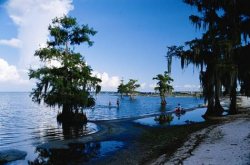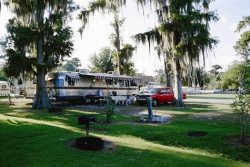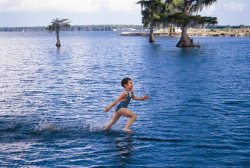History of Victor Guarisco Lake End Park
Lake Palourde
by Cy Provost
Lake Palourde, which has a surface area of approximately 17 miles, was named by the early French settlers. It was called “Lac Palourde,” which, when translated into English is “Lake Clam.” The abundance of clams found along the shore line became a staple in the diet of the early Indian inhabitants. Clams can still be found along the shore line bordering Highway 70 to Stephensville. Today, because of the abundance of crayfish, oyster, fish and crabs, the mussels (clams) found in the lake are not harvested. Many locals are not aware of this, but if carefully prepared these clams are delicious. One can feel the mussels submerged in the muddy bottom when walking in the lake. They are about the size of a man’s fist. Once you pick the mussel from the lake bottom it is necessary that you scrub the shell and edges briskly with a very stiff brush, cleaning them well. Now you can steam the shell open, butter the oyster-like body and consume, delicious. Other options are, of course, frying, and clam chowder; just let your imagination be your guide. The author has personally prepared the Palourde Lake Mussel in each of the above ways. They are tougher than an oyster but as good as any New England Clam. “Bon Appetit!”
In its first days, the area where you presently stand was on the outer perimeter of what was known as “Isle de Tige. It was named Tiger Island because early explorers found large cats here. As recent as 5 years ago a large Bob Cat was struck by a car on Fig Street within 1300 ft. from Lake End Park. It is important to note that this area (the park) fell within the Atakapas (Attakapas) and the Chitimacha Indian range. The Attakapas belonged to the same family as the Chitimacha and the Opelousa Indians. All of the tribes belonged to the Tunican group. The Attakapas had an undesirable reputation as Cannibals. The name Attakapas means man-eater. Upon the advent of the French, French ships came to the region for the express purpose of securing timber for its navy.

The Lake Palourde you see now consists of a body of water covering 11,520 acres. It is connected by streams to Grassy Lake to the North East and then Lake Verrett. These three impressive bodies of water are all part of the Atchafalaya Basin. Lake Palourde at one time was connected to the southwest by Flat Lake, but that connector between the lakes was severed by Highway 70 and a levee northeast toward Baton Rouge. You are now in the Americas largest river swamp, the last of its kind . The entire basin consists of 1,000,000 acres. This area is three and one-half times more productive in fish and wildlife resources than the Everglades! This Atchafalaya Basin of which Lake Palourde is a part has over three hundred species of birds ninety species of fish, crawfish, crabs and shrimp, sixty-five species of reptiles and amphibians; forty-six species of mammals. You are truly in a remarkable place. This is, in fact, one of the most extraordinary places in America.
You can see the American Symbol flying overhead daily. Look to the Carillon Tower. If you drive four blocks further than the tower and look to the wooded area from the road you can see the Eagle nest. If you look to the wooded area behind the canal in the park by the park keeper’s trailer, there is an Eagle nest five football fields away. It can be seen across the road from the hospital. You are in the center of an area leading the nation in Eagle nests. This is truly a birders’ paradise. Two years ago a white cardinal (bird) was spotted and verified. This sighting, which was across Highway 70 from the park, may never again be repeated in the United States. If you remain in our park over a period of time you see Kingfishers and Ospreys fishing in the park’s canal. Of course, the pelicans and ducks are in abundance. Alligators are frequently seen in the Lake and surrounding canals. Lake Palourde Park is the home of the black squirrel, try counting them as you walk the trail.
Remember, become a keen observer and nature will display all of its secrets. If fishing is your thing, go to a “Fishing Forecast for Lake Palourde” at (www.weather.com/outlook/recreation/outdoors/fishing/23797:21). Beside Striped Bass and Catfish, during low, low tides Black Drum are caught. Occasionally Porpoise are seen.

When camping or visiting Lake Palourde there are notable events of which you should be aware: As a camper, your appreciation of nature requires you to become familiar with the expected time of sunrise. Plan to schedule an outdoor breakfast while facing east. (Look toward the Carillon Tower across the lake.) Go out before dawn and prepare for a most beautiful spectacle, a glorious sunrise!
Secondly, don’t neglect the moonrise, particularly if the moon is in the full stage. Don’t miss a second, and as with the sunrise, get there before it starts! Again, look East across the lake. These are glorious experiences with an unequaled setting.
Incidentally the tower you see across the lake is one of the largest carillons (106 ft.) in the world and it is the focal point of the 9.5 acre Brownell Memorial Park.
While you are meditating on the lake and its beauty, do know that it has many hidden secrets. During the Civil War, Union Gunboats – part of the 30,000 man Union assault force stationed in Brashear City (Morgan City) – were sent out to clear the area of resistance, while in preparation for the assault on Confederate Fort Bisland in Patterson, LA.
You should know that in the vicinity of where you are camped, Confederate Troops in 1863, after the Red River campaign, landed a night-time amphibious assault to the rear of Brashear City (Morgan City) where Union Forts Brashear and Buchanan were captured in a rear attack. Remnants of Ft. Brashear (Star) remain, but Ft. Buchanan was completely destroyed by the construction of the levee. (Its site was at the junction of Levee Rd. and Front St., facing the river, in Morgan City.)
If you are fortunate enough to see the first Tarzan of the Apes movie made in 1917, you might recognize Lake Palourde in the movie. The sailing ship gliding across the silent film screen was moving across the Lake you are viewing now. The vision would be through cypress trees laden with the mysterious Spanish moss.
That same mysterious Spanish moss also hung in trees surrounding the body of the murdered husband in one of the most sensational crime cases of the 20th century. The Morgan City Public Library has copies of the book Ada and the Doc which explains the story of Ada Lebeauf and Dr. Dreher, who were both hanged for the murder of Ada’s husband. Ada was the first woman hanged in Louisiana’s 116 year history.


The lake has been the backdrop in the stories of the thousands of lives of the people who have lived for hundreds of years in the surrounding area. Its beauty is still featured in the photographs of the natives and the visitors. Take as many pictures as you like while you are here, but do not forget to experience the beauty of Lake Palourde as those thousands have enjoyed it before you. Live it and love it!
